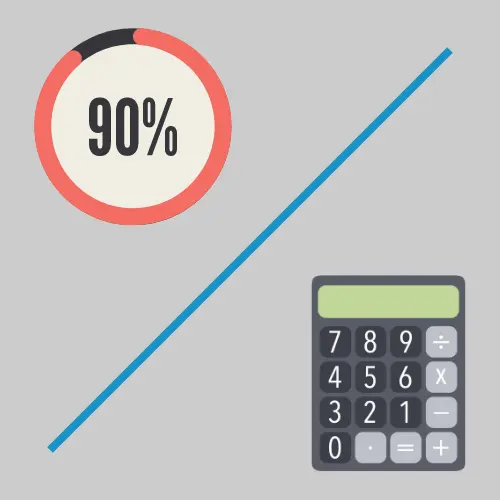There are many educational institutions where academic progress is still presented in percentage. Students from such institutions find it difficult to calculate CGPA equivalent to their percentage. I also used to find it hard to convert percentage to CGPA at the start. That’s why I wanted to develop an online converter to facilitate the students.

Formula to convert Percentage to CGPA
Let’s see how the tool above works and what formulas this tool is built upon. The general formula is:
CGPA = (Percentage/100) * Grade Scale
Here, the “Grade Scale” is a variable and a main factor.
Conversion example for Pakistani Universities
Higher Education Commission (HEC) is the regulatory body in Pakistan to deal with Higher Education Institutions (HEIs). HEC had standardized the grading scheme for all the HEIs back in 2015 and advised all the degree-conferring universities to follow a 4.00 point grading scale. This briefly means that the highest achiever will get 4.00 points.
For example, If your grading system is based on 4.00 points, and your percentage is 80%, then the equivalent CGPA will be (80/100) * 4= 3.20 CGPA.
If your institution has given your result in CGPA, then you can convert your CGPA to Percentage.
Conversion example for Indian Universities
University Grants Commission (UGC) is an authority in India that recognizes universities in India and manages higher education. The commonly used grading point is 10.00 in India, but some universities use 4.00 points also.
Now, let’s consider the same example of a student with a percentage of 80% and a grading scheme of 10.00 points. The equivalent CGPA will be (80/10) = 8 CGPA.
Conversion Guide for Percentage in CGPA
Having a conversion guide is very useful when you can’t access the internet and can’t use online converter tools or calculators. I’ll create a table showing percentages and their equivalent CGPAs. The first table shows the conversion to a 4.00 points grade scale, and the second table shows the conversion to a 10.00 points grading scale.
| Percentage | Out of 4 |
| CGPA of 95 | 3.80 |
| CGPA of 90 | 3.60 |
| CGPA of 85 | 3.40 |
| CGPA of 80 | 3.20 |
| CGPA of 75 | 3.00 |
| CGPA of 70 | 2.80 |
| CGPA of 65 | 2.60 |
| CGPA of 60 | 2.40 |
| CGPA of 55 | 2.20 |
| CGPA of 50 | 2.00 |
| Percentage | Out of 10 |
| CGPA of 95 | 10 |
| CGPA of 90 | 9.47 |
| CGPA of 85 | 8.95 |
| CGPA of 80 | 8.42 |
| CGPA of 75 | 7.89 |
| CGPA of 70 | 7.37 |
| CGPA of 65 | 6.84 |
| CGPA of 60 | 6.32 |
| CGPA of 55 | 5.79 |
| CGPA of 50 | 5.26 |
Cumulative Grade Point Average (CGPA)
The Cumulative Grade Point Average measures a student’s academic performance in a degree program. It is normally used based on a Grade Point System (GPA). CGPA is calculated by taking the average of the GPAs a student earns in multiple semesters. If I break down the components of CGPA, I would left with GPA and Credit Hours.
Grade Point Average (GPA)
GPA represents the student’s academic performance for a semester or a term in numeric form. It can be calculated by assigning a numeric value to letter grades and taking an average of these values. Credit hours of each course are also considered in this calculation. Universities normally have their own criteria for assigning numeric values of letter grades depending on the degree program.
Credit Hours
Each course in a degree program has associated credit hours that represent the amount of workload or student’s time for that specific course in a week. For example, the Advanced Computer Architecture course required 3 credit hours toward the degree completion. It means that the student who is enrolled in this course for this degree program must give 3 hours of their time in a week to this course. It is up to the university’s discretion to organize a single lecture of 3 hours or arrange two classes of 1.5 hours.
Understanding Different Grading Systems
Let’s see how many grading systems are usually available in academic institutes. I’ll briefly go through the main grading systems so you can get an idea about them. The order below does not matter; I am trying to start with the simplest one.
Pass/Fail system
The pass/fail system is one of the basic grading systems in which the student only knows if they have passed the exam. It does not tell the student about their performance score, how much they have done well, and how far they were from passing the exam.
Percentage-based grading system
In the percentage-based system, the student’s performance is evaluated based on the percentage they get from their marks. It gives the achievement score in percentage.
CGPA-based grading system
The cumulative Grade Point Average grading system is based on the Grade Point Average system in which every course is assigned a number based on the scale defined by the university. The most commonly used grading scales are 4 and 10 points.
